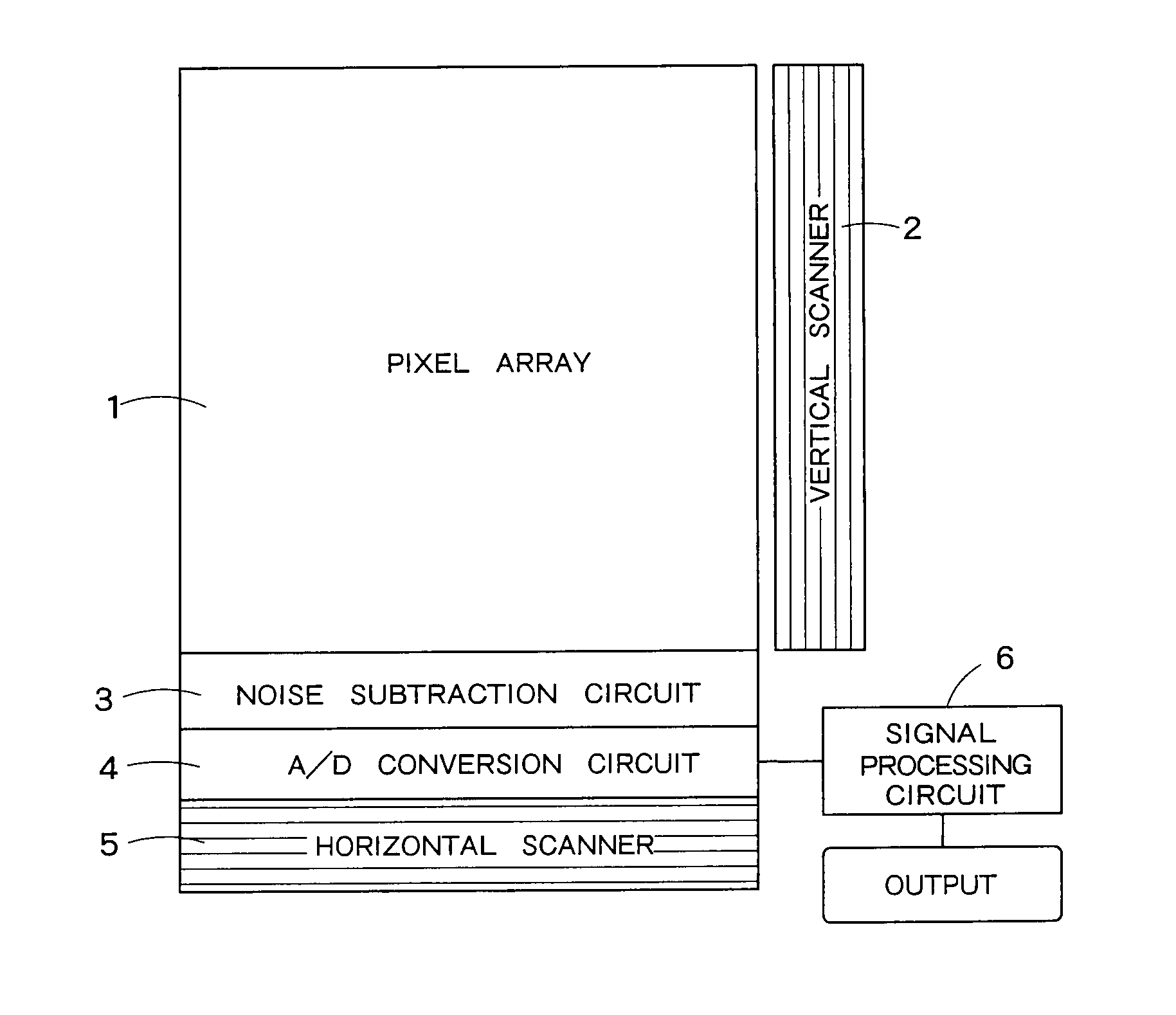Solid-state image sensing device
a sensing device and solid-state technology, applied in the direction of radio frequency controlled devices, instruments, television systems, etc., to achieve the effect of high sn ratio, no deterioration of resolution, and good color reproducibility
- Summary
- Abstract
- Description
- Claims
- Application Information
AI Technical Summary
Benefits of technology
Problems solved by technology
Method used
Image
Examples
first embodiment
[0063]FIG. 1 is a block diagram showing a schematic configuration of a solid-state image sensing device according to one embodiment of the present invention. The solid-state image sensing device in FIG. 1 has a pixel array 1 in which a plurality of pixels having photoelectric conversion elements are arranged in matrix form, a vertical scanner 2 for sequentially supplying drive voltages to the respective rows in the pixel array 1, a noise subtraction circuit 3 for removing noise contained in an imaging signal photoelectrically converted in the individual pixel, an A / D conversion circuit 4 for the A / D conversion of the imaging signal output from the noise subtraction circuit 3, a horizontal scanner 5 for sequentially selecting imaging data after the A / D conversion row by row and reading the imaging data, and a signal processing unit 6 for performing signal processing described later with respect to the imaging data.
[0064]The imaging data is serially input to the signal processing unit...
second embodiment
[0118]A second embodiment is different from the first embodiment in the kind of pixel line used for an edge judgment.
[0119]In the example described in the first embodiment, as shown in FIG. 14(a) to FIG. 14(d) or FIG. 15(a) to FIG. 15(d), three lines are set as comparison targets for edge detection in a pixel block, and the central line among these lines includes a W pixel targeted for signal processing located in the center of the pixel block.
[0120]The pixel line targeted for comparison does not necessarily have to include the W pixel targeted for signal processing located in the center of the pixel block. Thus, in the second embodiment described below, the edge judgment is carried out using two lines adjacent to the central W pixel. Moreover, the second embodiment is characterized in that the kind of two pixel lines targeted for comparison is the same.
[0121]FIG. 16 is a flowchart showing a processing operation of a signal processing unit 6 configured as in FIG. 12 in the second em...
third embodiment
[0127]In a third embodiment, a region having no edge is detected around a target W pixel, and color separation processing is performed in this region.
[0128]FIG. 18 is a flowchart showing the processing operation of a signal processing unit 6 according to the third embodiment, and FIG. 19(a) to FIG. 19(c) are diagrams explaining pixel lines used in an edge judgment.
[0129]First, a color pixel value in a pixel block including a W pixel in the center is acquired (step S21). Then, the central W pixel is used as a pixel targeted for signal processing to calculate the total of the color pixel values of a vertical line LineV0 including the W pixel, the total of the color pixel values of each of two vertical lines LineV1, LineV2 located on both sides of the vertical line LineV0 across one pixel, the total of the color pixel values of a horizontal line LineH0 including the W pixel, the total of the color pixel values of each of two horizontal lines LineH1, LineH2 located on both sides of the ...
PUM
 Login to View More
Login to View More Abstract
Description
Claims
Application Information
 Login to View More
Login to View More - R&D
- Intellectual Property
- Life Sciences
- Materials
- Tech Scout
- Unparalleled Data Quality
- Higher Quality Content
- 60% Fewer Hallucinations
Browse by: Latest US Patents, China's latest patents, Technical Efficacy Thesaurus, Application Domain, Technology Topic, Popular Technical Reports.
© 2025 PatSnap. All rights reserved.Legal|Privacy policy|Modern Slavery Act Transparency Statement|Sitemap|About US| Contact US: help@patsnap.com



